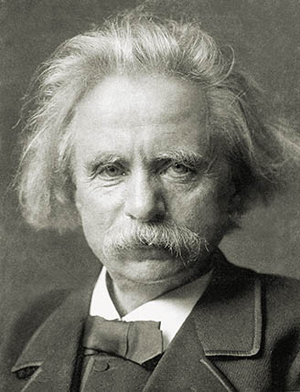

A New Look at a Nation’s Composer
Ragna Moe ’83E (MM) admits she’s a bit of a missionary when it comes to getting people interested in the arts. That passion came in handy this year as the musician and arts administrator organized her native Norway’s national celebration of the centennial of composer Edvard Grieg’s death.
“I like to spread the gospel about the arts,” Moe says. “But I also hope to give people a better sense of who Edvard Grieg was, his music, his work, and his humanism.”
 GRIEG STATE: “There are many people all over the world who know Grieg’s music,” says Ragna Moe ’83E (MM), who oversaw a year-long commemoration of Norway’s most famous composer. (Photo: New York Public Library)
GRIEG STATE: “There are many people all over the world who know Grieg’s music,” says Ragna Moe ’83E (MM), who oversaw a year-long commemoration of Norway’s most famous composer. (Photo: New York Public Library)Best known as a composer who drew on Norway’s natural settings and folk music traditions, Grieg was an influential artist in the latter half of the 19th century whose lyrical and Romantic compositions remain part of the orchestral repertoire.
He’s perhaps best known for his incidental music for Ibsen’s Peer Gynt, and as Moe describes his music, she can’t help but hum “In the Hall of the Mountain King,” part of the Peer Gynt cycle that sometimes shows up in TV commercials and often gets piped through shopping malls.
“There are many people all over the world who know Grieg’s music, but they may not know that it’s Grieg,” Moe says.
Moe, who is a native of Bergen, the same Norwegian town where Grieg was born, was the director of the Grieg museum at the composer’s home before heading up the centennial. As director, she has emphasized the ways that music can reach out to children by involving them in projects to understand how music is composed. Grieg was known to spend a lot of time walking through Norway’s natural areas and listening to the country’s folk musicians, traditions that can be heard in his work.
As part of the centennial, Moe helped organize a children’s sampler, in which kids learned how to record such natural sounds as a way to understand the “music” all around them. Many of the recordings can be heard through the centennial’s Web site at http://eng.grieg07.no.
A bassoonist, Moe enrolled at the Eastman School on the advice of a violinist friend, and she studied with David Van Hoesen, professor emeritus, an experience that she describes as “wonderful.” While at Rochester, she also began to recognize how the roles of artists and arts administrators intertwine.
She went on to earn a master’s degree in arts management from the College-Conservatory of Music at the University of Cincinnati.
“It’s an interesting challenge to find the balance between artistic and managerial leadership,” she says.
But she notes, the lessons of studying music resonate with the lessons of managing an arts organization. “There’s so much of what you need as a musician that you use as an arts manager,” Moe says. “You need discipline; you need to know how to present a message with zeal.”
Culminating with a festival and symposium in Bergen in September, the Grieg centennial formally ends this fall. While the music took center stage, Moe hoped that fans of his music would also discover that Grieg was an ardent and often outspoken supporter of democracy and the rule of law throughout Europe. Part of the symposium focused on his commitment to human rights.
Moe says that aspect of Grieg’s work is often overlooked.
“[His music is] very much a part of the Norwegian soul,” Moe says. “But I think the centennial has made the Norwegian people aware not only of his music but also of his work as a humanist. It has been a real eye-opener.”
—Scott Hauser
